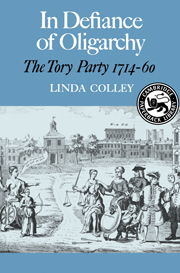Book contents
- Frontmatter
- Contents
- For my parents and Toby
- Preface
- Part I The Problem of Tory Survival
- Part II The Ingredients of Tory Survival
- Part III Single-Party Government Assailed
- 7 A Dark Hole with Blind Guides: 1714–24
- 8 The Twisted Threads of Party: 1725–41
- 9 Broad-Bottom Schemes and Princely Alliances: 1742–53
- 10 Acceptance and Dispersal? 1754 and Onwards
- Conclusion
- Appendix
- Manuscript Sources
- Notes
- Index
8 - The Twisted Threads of Party: 1725–41
Published online by Cambridge University Press: 03 February 2010
- Frontmatter
- Contents
- For my parents and Toby
- Preface
- Part I The Problem of Tory Survival
- Part II The Ingredients of Tory Survival
- Part III Single-Party Government Assailed
- 7 A Dark Hole with Blind Guides: 1714–24
- 8 The Twisted Threads of Party: 1725–41
- 9 Broad-Bottom Schemes and Princely Alliances: 1742–53
- 10 Acceptance and Dispersal? 1754 and Onwards
- Conclusion
- Appendix
- Manuscript Sources
- Notes
- Index
Summary
The hybrid opposition which confronted Sir Robert Walpole after 1725 is one of the great set-pieces of eighteenth-century English history, and its tactics and press campaign have been chronicled many (some would say too many) times. Few tories would have been as reverential about the distinction of this period as some of its historians are. They had been opposing not only Walpole, but also the party and much of the governmental system he represented, since 1714. For many of them, parliamentary co-operation with the growing number of dissident whig peers and M.P.s was only a way of continuing the same battle by different means. ‘They vote with You’ a government pamphleteer told William Pulteney in 1731, ‘because You now proceed with Violence against a Person who is one of the greatest Enemys to Tory Principles …they hate the Whig as much as You hate the Man.’ In a pamphlet rejoinder Pulteney denied neither the binary composition of the opposition nor the implication that for him ousting Walpole was its prime purpose: ‘The Whigs who oppose you, are neither governed by the Tories, nor are the Tories govern'd by them; but they act in Concert together (and may they long continue to do so!) because it is their united Opinion that you are a wicked, as well as a weak Minister.’ Disagreement on policy, if not an eventual betrayal of one party group by the other, was built into the coalition from the start.
- Type
- Chapter
- Information
- In Defiance of OligarchyThe Tory Party 1714-60, pp. 204 - 235Publisher: Cambridge University PressPrint publication year: 1982



